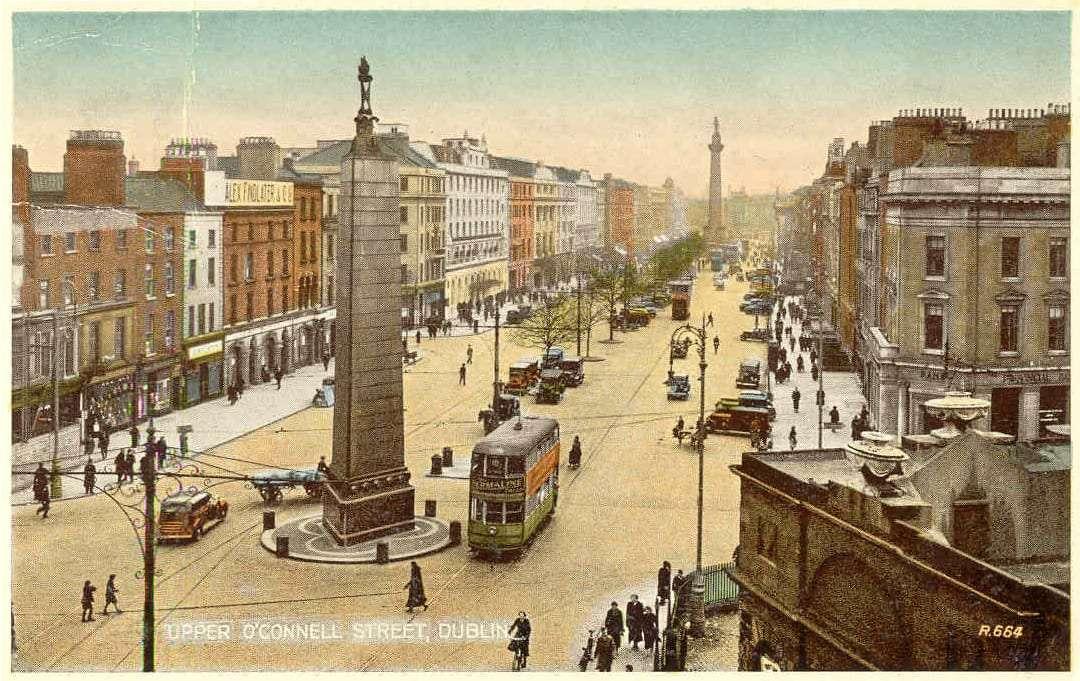
Celebrating a Century: 100 Years of O’Connell Street’s Rich History in Dublin
- Wed, 29 May 2024
Historical Overview of O’Connell Street
O’Connell Street, at the heart of Dublin, has remained central to Ireland’s history for centuries. Through name changes, revolutions, destruction, and rebuilding, it has consistently been a pivotal part of the nation’s story.
Historical Timeline of O’Connell Street (1924-2024)
1924-1930s: Early 20th Century Developments
- 1924: O’Connell Street was already a central hub in Dublin, known for its broad, elegant layout and prominent buildings.
- 1928: The construction of the General Post Office (GPO) was completed, solidifying its status as an architectural landmark and historical symbol due to its role in the 1916 Easter Rising.
1940s-1950s: Wartime and Post-War Era
- 1941: The street suffered damage during the North Strand bombings in World War II, impacting several buildings.
- 1950s: Post-war reconstruction led to the modernisation of many structures, preserving the street’s significance as a commercial and social centre.
1960s-1970s: Modernisation and Challenges
- 1966: The fiftieth anniversary of the Easter Rising saw a major commemoration at the GPO, with new monuments and public interest in the street’s historical role.
- 1974: The construction of the Carlton Cinema at the north end of the street represented the increasing commercial development of O’Connell Street.
1980s-1990s: Urban Renewal Efforts
- 1988: Dublin celebrated its millennium year, bringing a renewed focus on urban renewal projects, including plans for O’Connell Street.
- 1990s: Several redevelopment projects were initiated to enhance pedestrian access, public spaces, and transport facilities.
2000s: Modern Transformation
- 2003: The Spire of Dublin (Monument of Light) was built as part of the O’Connell Street Integrated Area Plan, symbolising the modern rejuvenation of the area.
- 2004-2006: Major renovations were completed, including widened pavements, new lighting, and improved street furniture to revitalise the street’s aesthetic and functionality.
2010s: Continued Development and Cultural Significance
- 2013: The introduction of the Luas Cross City tramline added a modern transport dimension, improving connectivity and accessibility.
- 2016: Centenary commemorations of the 1916 Easter Rising saw extensive public events and a resurgence of interest in the historical aspects of O’Connell Street.
2020s: Recent Developments and Future Prospects
- 2020: Pedestrianisation initiatives were proposed to enhance the street’s appeal and reduce traffic congestion.
- 2022: Plans for further redevelopment included enhancing the cultural and historical aspects of O’Connell Street, making it a more attractive destination for both locals and tourists.
- 2024: As O’Connell Street celebrates its continuous evolution over the past century, it remains a vibrant blend of historical significance and modern urban life.
Architectural Landmarks and Monuments on O’Connell Street
Historical Significance: The GPO is one of Dublin’s most iconic buildings, famously serving as the headquarters of the leaders of the 1916 Easter Rising. This rebellion was a pivotal moment in Irish history, marking the fight for independence from British rule.
Architectural Features: Completed in 1818, the GPO features a neoclassical design with a grand façade, characterised by its six Ionic columns and a triangular pediment. The building’s historical and architectural prominence makes it a central symbol of Irish nationalism.
Current Use: Today, the GPO functions as a working post office and houses the GPO Witness History Visitor Centre, which offers exhibits on the Easter Rising and Irish history.

The Spire of Dublin (Monument of Light)
Historical Significance: Built in 2003, the Spire stands at the former Nelson’s Pillar site, which was destroyed in a bombing in 1966. The Spire represents modern Ireland and its aspirations for the future.
Architectural Features: The Spire is a striking contemporary landmark, standing 120 meters tall with a sleek, tapering design that reflects light. It is intended to symbolise renewal and progress.
Cultural Impact: As a modern addition to O’Connell Street, the Spire has become a prominent meeting point and a distinctive feature of Dublin’s skyline.

The O’Connell Monument
Historical Significance: Built in 1882, this monument commemorates Daniel O’Connell, a key figure in Irish history known as “The Liberator” for his efforts in achieving Catholic Emancipation in the early 19th century.
Architectural Features: The monument features a statue of O’Connell atop a large plinth, surrounded by figures representing the various aspects of his life and achievements. It is a centrepiece of O’Connell Street, reflecting the street’s namesake and his contributions to Ireland.
Cultural Impact: The O’Connell Monument is a focal point for parades and public gatherings, emphasising its role in Dublin’s social and political life.

The Parnell Monument
Historical Significance: Dedicated to Charles Stewart Parnell, an influential nationalist leader, this monument stands at the northern end of O’Connell Street. Unveiled in 1911, it honours Parnell’s leadership in the Irish Parliamentary Party and his advocacy for Home Rule.
Architectural Features: The monument includes a statue of Parnell holding a roll of parchment, symbolising his legislative efforts, atop a high plinth adorned with bronze reliefs depicting scenes from his life.
Cultural Impact: The Parnell Monument serves as a historical marker, reminding passersby of Parnell’s enduring legacy in the fight for Irish self-governance.

The Jim Larkin Statue
Historical Significance: Built in 1979, this statue commemorates James Larkin, a prominent labour leader and founder of the Irish Transport and General Workers’ Union. Larkin played a significant role in the Dublin Lockout of 1913, a major industrial dispute.
Architectural Features: The bronze statue depicts Larkin with arms outstretched, symbolising his role in rallying the working class and his powerful oratory skills.
Cultural Impact: The statue is a tribute to Dublin’s working-class heritage and the city’s labour movement, reflecting the street’s diverse historical narrative.

Cultural Impact and Significance of O’Connell Street
Parades and National Celebrations
St. Patrick’s Day Parade: O’Connell Street is a focal point for Dublin’s St. Patrick’s Day celebrations, drawing large crowds to witness vibrant parades featuring floats, performers, and musicians. This event highlights Irish culture and heritage to both locals and international visitors.
Easter Rising Commemorations: The street plays a significant role in commemorating the 1916 Easter Rising, with annual events and parades that honour the leaders and participants of this pivotal moment in Irish history. The GPO, in particular, serves as a central point for these commemorations.
Political Rallies and Demonstrations
Public Demonstrations: Various political groups and social movements have used O’Connell Street to voice their demands, from anti-austerity protests to climate change rallies. The street’s centrality and visibility make it an effective stage for public discourse.
Cultural Festivals and Public Gatherings
Culture Night: As part of Dublin’s annual Culture Night, O’Connell Street hosts a variety of performances, art installations, and cultural showcases. These events highlight the street’s role in promoting the arts and engaging the community.
Entertainment and Commerce
Shopping and Dining: The street is lined with shops, cafes, and restaurants, making it a bustling commercial hub. This blend of retail and culinary offerings attracts both locals and tourists, contributing to its lively atmosphere.
Historical Commemorations and Monuments
Annual Remembrances: Various annual events and ceremonies take place at the monuments along O’Connell Street, such as those for Daniel O’Connell, Charles Stewart Parnell, and James Larkin. These commemorations keep historical figures and their contributions to Irish society in the public consciousness.
Heritage Walks and Tours: Guided tours often include O’Connell Street as a significant stop, educating participants about Dublin’s history, architecture, and the street’s role in key historical events.
Photographic Journey Through Time

O’Connell Bridge and Sackville Street, Dublin / Photo: National Library of Ireland on The Commons (1890)

View from top of Nelson’s Pillar, Sackville Street, Dublin, circa 1921 / Photo: National Library of Ireland

Abbey Street and Sackville Street, Dublin, May 1916 / Photo: Keogh Brothers Ltd., National Library of Ireland on The Commons

Sackville Street, Dublin, post-1916 Easter Rising / Photo: Miller, James Martin & H.S. Canfield

O’Connell Bridge, Dublin circa 1928 / Photo: Eason Photographic Collection

A half-demolished Nelson’s Pillar on O’Connell Street, Dublin / Photo: The Irish Times, 8 March 1966

Photo: Robert Linsdell
Future Outlook
The future of O’Connell Street looks to be a blend of modern innovation and historical preservation. O’Connell Street will continue to be a central and vibrant part of Dublin’s cultural and economic fabric. Its ongoing relevance will be maintained through thoughtful development that respects its past while looking towards the future.


